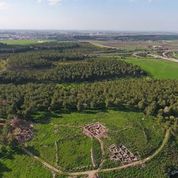By Marney Blom
An unprecedented archeological artifact was discovered this week at Khirbat er-Ra’i in the Southern District of Israel. For the first time, an inscription dating back to the period of the biblical Judges was uncovered. The 3,100-year-old text, bearing the name Jerubbaal in alphabetic script, was found on a pottery shard inside a storage pit lined with stones.
“The name Jerubbaal is familiar from biblical tradition in the book of Judges as an alternative name for the judge Gideon ben Yoash,” said Prof. Yossef Garfinkel, curator of the museum Yarmukian Culture and specialist in Protohistoric era of the Near East. “ … this inscription may refer to another Jerubbaal and not the Gideon of biblical tradition, although the possibility cannot be ruled out that the jug belonged to the judge Gideon [of the Bible].”
Both a judge of ancient Israel and a local hero, biblical Gideon lead a mere company of 300 Israelite soldiers to defeat the mighty Midianite army.
The inked text of the name Jerubbaal was discovered etched on a one litre jug used for carrying precious liquids such as oil, perfume or medicine and likely identifies the owner of the vessel. What makes it rare is Jerubbaal has never been found on an artifact in a stratum dated back to 1,100 BC — the period of the judges of the Bible.
Epigraphic expert Christopher Rolston of George Washington University, Washington DC was tasked with deciphering the inscription. According to Rolston, the text contains the Hebrew letters yod, resh, bet, ayin, lamed and remnants of several other letters.

Photo credit: Emil Aladjem, Israeli Antiquities Authority
This rare discovery will do much to advance archaeologists’ understanding of the transition of the alphabetic script from the Canaanite to the Israelite period. The Canaanites, under the Egyptian influence of the Middle Bronze Age (1,800 BC), were the first to develop the original alphabet. However, the destruction of the city of Lachish, the centre of Canaanite language development in 1,150 BC, left few clues as to how the alphabetic script had been preserved. The Jerubbaal inscription found at Khirbat er Ra’i, roughly four kilometres from Lachish, could help to solve that mystery.
Prof. Garfinkel, along with Dr. Kyle Keimer, Dr. Gil Davies and Sa’ar Ganor direct the excavations at Khirbat er Ra’i on behalf of the Institute of Archaeology at the Hebrew University of Jerusalem, the Israel Antiquities Authority and Macquarie University in Sydney, Australia.
Marney Blom is news director for the Acts News Network.
Copyright 2021 © Acts News Network, Inc.

